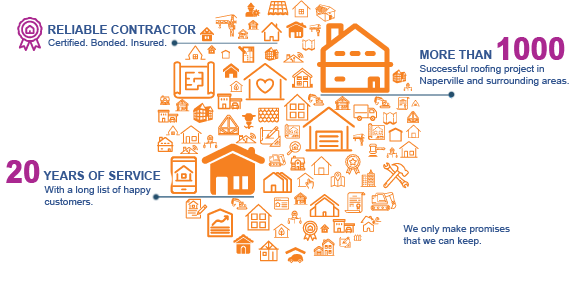Reroofing vs. Roof Replacement: What is The Best Option for Your Home? (Complete Comparison)
All components of a home are important, but some more than others. Take the roof as a prime example – without it, everything in the home would go to ruin. That’s why homeowners are so invested in the conversation around reroofing vs. roof replacement. The dreaded thought of moisture entering the home and wreaking havoc is something that will eventually cross the mind of homeowners, especially those whose roof is old or has recently been subjected to a damaging storm.
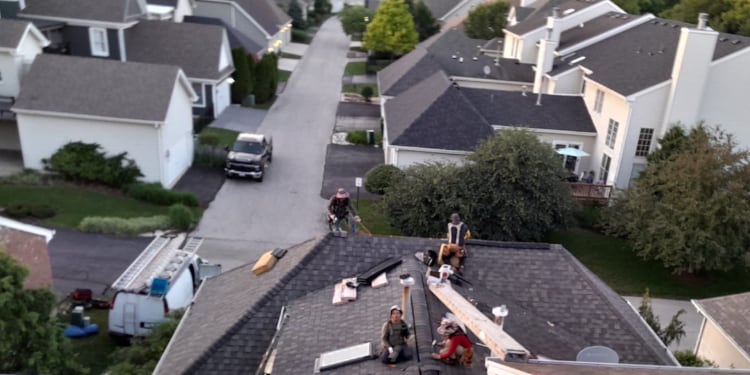
Fortunately, you’ve come to the right place where all the information you need is covered and will help you make the decision about reroofing or roof replacement. With a wealth of insights, you can judge for yourself which direction you should go and have confidence in your decision.
Table of contents:
- WHY IS IT IMPORTANT TO KNOW THE DIFFERENT ROOFING OPTIONS

- WHAT IS REROOFING?

- WHAT IS A ROOF REPLACEMENT?

- WHAT IS THE DIFFERENCE BETWEEN REROOF AND NEW ROOF?

- A COMPLETE OVERVIEW ABOUT REROOFING

- REROOFING COST

- WHEN TO CONSIDER REROOFING SERVICES

- AN IN-DEPTH LOOK AT ROOF REPLACEMENT

- ROOF REPLACEMENT COST

- WHEN TO CHOOSE A ROOF REPLACEMENT SERVICES

- REROOFING VS ROOF REPLACEMENT

- THE MAJOR DIFFERENCES BETWEEN REROOFING AND ROOF REPLACEMENT

- COST OF REROOFING VS. ROOF REPLACEMENT

- HOW TO DECIDE BETWEEN REROOFING AND FULLY REPLACING THE ROOF

- MAKE A FINAL DECISION: WHAT IS THE BEST ROOFING OPTION FOR YOU?

- CHOOSE THE BEST ROOFER FOR FULL ROOF REPLACEMENT IN THE DUPAGE COUNTY

Why is it important to know the different roofing options
Making an informed decision about a purchase is something every consumer strives to do, but when it involves a significant expenditure, the information you need to make the decision becomes vital rather than simply preferred. Significant among these decisions is selecting a roofing contractor – one that will provide you with guidance about the state of your roof and present you with roofing options, including reroofing and roof replacement.
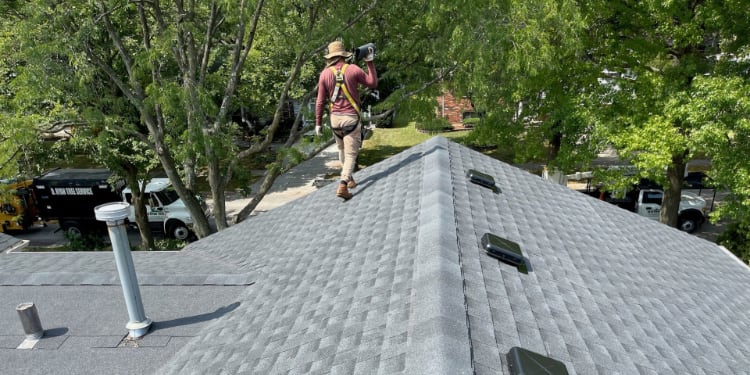
But let’s begin with the distinction between reroofing and roof replacement, because they seem to have the same meaning. They are, in fact, quite different because one involves the removal of all the components and installing all-new materials, and the other is related to simply addressing old shingles. The price difference and the amount of work involved in each is quite different, which is why the distinction is so important.
What is reroofing?
Don’t be afraid to ask the question of your contractor, “what does reroofing mean?” because it’s something they’ve gotten time and again and they know how important their answer is. Reroofing is the process of installing new shingles on top of old shingles.
Reroofing is something a contractor will recommend when your existing shingles have reached the end of their lifespan but everything under the shingles is still in great shape. This means the all-important foundation of ¾-in. plywood (often referred to as decking) is intact and able to protect your home for many years, the felt paper and moisture barrier are sound and you have no significant damage that needs to be addressed prior to your new shingles going on.
Another way contractors answer “what is reroofing?” is to say it is “less work and less costly than a roof replacement.”
What is a roof replacement?
Yet another question you shouldn’t be shy about with your roofing contractor is, “what is a roof replacement.” Again, this is a question they get frequently and it too is important. A roof replacement is the removal of old roofing components, which includes shingles and all the roofing material under it, except for the decking, and the replacement of each of those components with brand new material.
The components of a roof include the outermost layer, which is shingles, and then the felt paper, which is also called underlayment. Depending on the roof, components could also include an ice and water shield, which is a waterproof membrane that protects gulleys of the roof, and a drip edge, which is metal flashing for extra protection around the edges of the roof. Roof replacement is more extensive and more expensive than reroofing.
What is the difference between reroof and a new roof?
Now that you’ve gotten the contractors’ definition of reroofing and roof replacement, we need to clear up reroof vs. new roof. Again, they sound like the same thing, but they are not. In fact, the distinction is that a new roof is the same as a roof replacement, because not only are you going to have new shingles, but with a new roof, all the roofing components under the shingles have been replaced with new materials.
A new roof is going to be a more extensive project than a reroofing because you’re having all the components professionally stripped off the roof and new materials installed. When you reroof, you’re simply placing new shingles on top of the old shingles. But a new roofing project will require the contractor to bring in a dumpster, tear off all the old components, clear the decking of old nails and other old material and then move on to the installation phase.
There is a lot more labor involved with installing a new roof, as the contractor is paying for his crew to rip off the old materials and move the refuse to a dumpster. It can get quite messy, so there is a lot of cleanup involved. Fortunately, having that new roof installed will last you many, many years and you may never have to embark on a project like this again.
A complete overview about reroofing
Looking for a quick way to gain years of leak protection and improve the appearance of your roof? Reroofing accomplishes that, as you’re installing new shingles over the old ones. It’s akin to a quick rejuvenation without all the cost of a completely new roof.
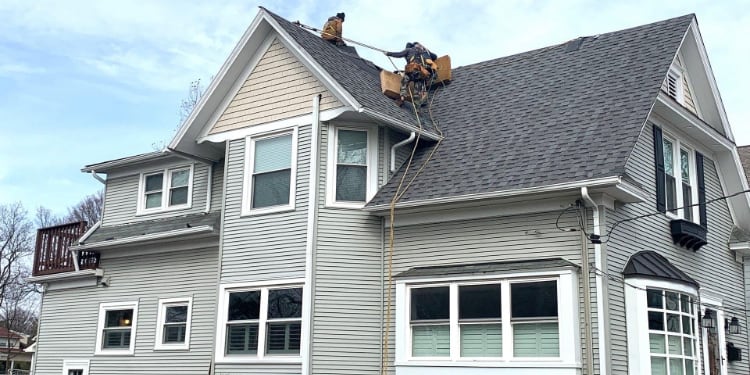
The process usually begins with an inspection of your whole roof and the contractor can make sure that everything under your old shingles is still in good condition. At that point, they can recommend getting new shingles, but they must also ensure you’ve only got one layer of shingles on your roof currently, as any more than one layer will require the removal of the shingles, and essentially, a whole new roof.
All that is left to do is to choose the type of shingles you want to go over your old ones. Your roofing contractor should have years of experience in this area, helping you to choose between budget-friendly three-tab shingles or more heavy-duty and costly architectural or premium shingles.
Reroofing, while less costly than roof replacement, is also less time consuming. With less work to do, less time is required to complete the project. When you partner with the right contractor for reroofing services, they will fill you in on the estimated timeline, as well as the cost estimate.
There are several pros and cons of reroofing including:
The pros of reroofing a house
There are some obvious pros to reroofing a house, less cost being one of them, but you also have added protection to your home once you’ve taken on a project like this. Check out the following pros for reroofing your home:
Enhances home appearance
Shingles are the outermost layer of your roof, so that’s the only component visible. Brand new shingles really enhance the home, giving it curb appeal and an attractive new appearance.
Strengthens your roof
Your new shingles add a layer of protection for years to come, as new shingles have fresh protective granules on them that enhance their protective qualities. Also, you’re adding a second layer of shingles, which only adds to the leak prevention factor.
Budget-friendly option
It’s always good news when the contractor says your roof is a good candidate for reroofing rather than replacement, as reroofing is perfect for anyone on a tight budget and it doesn’t take as long as a roof replacement. This cost savings can also allow a little wiggle room in your budget for more premium shingles. But generally speaking, the cost of a reroofing project is about half that of a roof replacement.
Fast and easy process
If you want your project to be over and done in fast fashion, reroofing is the way to go, as there is no material removal and less material installation involved, therefore less labor and less time.
The cons of reroofing
With every list of pros comes a list of cons and it’s no different with reroofing a house. Indeed, there will be drawbacks for some, but does that mean it’s the wrong decision? Check out some of the cons and see if they influence your decision.
Temporary roofing solution
Contractors will tell you upfront that reroofing will not last as long as a roof replacement. In fact, it’s a temporary fix, as many will consider it to be “patchwork” over an older roof and could hide future problems.
Two-layer limit
Shingles are dense and heavy, and roofs are not engineered to hold more than two layers. Ordinances exist that ban going over two layers, which is smart because it protects homeowners from potential collapse.
Requires only asphalt shingles
You won’t have flexibility on material type with a reroofing project, as you can only add a layer onto asphalt shingles with asphalt shingles. You won’t see contractors attempting this with wood, slate, clay or metal roofing materials, as it isn’t practical.
Hidden roof damages
Even the best contractors can miss small damaged areas, which will become bigger issues later, but a reroofing project will hide those areas that might otherwise be seen later. The risk is that you could miss decking problems, which is considered major damage and will probably cause interior damage in the near future.
Short roof lifespan
Most new roofs will give homeowners 20 to 30 years of protection and even longer in some situations. Most reroofing projects will last no longer than 15 years.
Limited capability to inspect a damaged roof
You have to be an experienced, veteran roof inspector to catch potential damages under a reroofed home. Without the luxury of tearing off all the shingles and revealing the decking, it's nearly impossible to know if the decking needs to be repaired or replaced.
Manufacturer warranties are void
Manufacturers offer a warranty on new construction, as they know their products will last a specific number of years in the right conditions. However, those conditions are not present in a reroofing project, which is why they void their warranties.
Lower house resale value
Potential homebuyers shy away from homes that have been reroofed. So in order to make the reroofed home more attractive on the market, sellers will often have to discount the price of the home.
You double the weight on your support structures under the roof that has two layers of shingles. Also, double-layered roofs tend to trap heat and warm up more than a roof with a single layer of shingles. This will negatively impact the lifespan of the shingles.
Reroofing cost
Homeowners on a tight budget hope their roofing contractor will offer the good news that they are a candidate for reroofing rather than a roof replacement, as reroofing is much friendlier on the budget. This, and the fact that reroofing takes only about a day’s work, make it very appealing to homeowners.
There are many factors that go into the price tag of a reroofing project, as the type of shingles you use, the size of your roof and the workability (steepness) of it all impact total reroofing fees. As a general rule of thumb, start with an estimate of around $7,000 for reroofing. If your house is super small and easy to work on, you will probably pay less than that. If your home is large and it will be difficult to install new shingles on it, you will probably pay more than $7,000. Your roofing contractor should come up with a close estimate after inspecting your roof.
When to consider reroofing services
Given what you know now about reroofing services, what they cost and the good and the bad about them, what do you think? Is reroofing a good option for your home? To reiterate, here are the three top things you need to consider before making a decision:
End of roof lifespan
If your shingles have reached the end of their lifespan but the other component of your roofing system is in good shape, you’re a good candidate for reroofing.
Minor leaks
Reroofing can put an end to minor leaks, as your old shingles might be letting some moisture through and the new ones will “plug” the compromised areas.
Partial roof issues
One of the most cost-effective maintenance items you can tick off the list is to reroof only the section of your roof that needs it. If the remainder of your roof is looking good, it’s super budget friendly to reroof instead of replace.
Whether you’re looking to sell your home and get that all-important curb appeal that new shingles offer or if you’re just looking to get a handful of years of protection, reroofing is a solid option. Just keep in mind that most contractors see this as a temporary solution and will likely recommend roof replacement in the near future.
An in-depth look at roof replacement
Saving money on a reroofing project is great, but there are times when that’s just not an option and you’ll be forced to take on a more extensive roof replacement project. Such is the case when you’ve got a sagging support structure, which is an indication that everything needs to come off, including some or all of the decking, and major work needs to take place before you can have the new shingles installed.
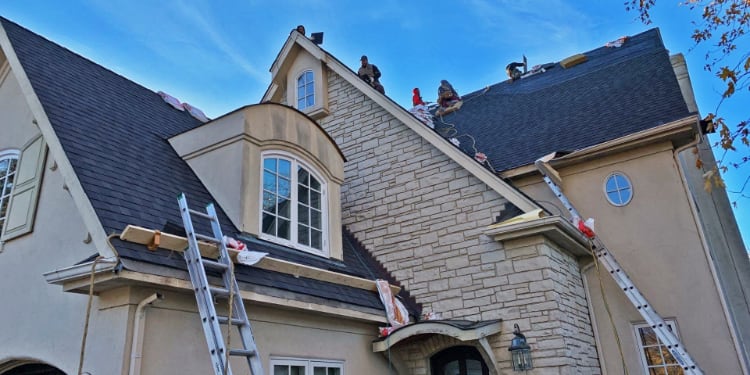
It’s not always that extreme. In some cases, the roof replacement is required because you’ve already got two layers of shingles on the roof and the building codes don’t allow for a third layer, nor will your structure support three layers.
Even if you only have one layer of shingles, you might still be a candidate for roof replacement because the layers of roofing material under the shingles are also in bad shape. This means your roofing contractor will need to tear everything off and start new with fresh materials, including felt paper (underlayment), flashing and other roofing components.
When the goal for your roofing project is for it to last for decades, a complete roof replacement is what you need. This will also give your contractor complete visibility to areas of the roof they otherwise wouldn’t see, because when they strip everything away, they have a clear view of trouble areas they can address before installing the new materials.
Your best move going forward is to communicate your concerns with your roofing contractor and they will provide you with all the options that will benefit your home.
There are several pros and cons of roof replacement including:
The pros of complete roof replacement
A complete roof replacement is the best way to get the most life out of your roofing project. At the completion of the job you will know you’ve done the most you possibly can to protect your home. Consider these pros that homeowners most often bring up about their roof replacement.
No layer limit
It doesn’t matter how many layers you’ve got on your roof when a replacement is needed. It’s one less variable to worry about.
New exterior appearance
You don’t have to worry about curled shingles or uneven appearances like you do with a reroofing project, because a roof replacement starts with a clean slate, allowing roofers to get the highest amount of curb appeal.
Long roof lifespan
The longest possible lifespan you can get out of a roof project is with a completely replaced roof. It’s not uncommon for a replaced roof to last two or three decades.
Variety of roofing materials
Want to replace your roof with metal, slate, clay or wood? It’s not a problem with a roof replacement, unlike being held to asphalt shingles with a reroofing project.
Opportunity for roof Inspection
A roof replacement involves tearing away all the old materials and installing fresh roofing components, which means when it’s all off, your roofing contractor gets a good look at what’s underneath. The smallest issues might not be a problem now, but they can be fixed before new material is installed so there is no chance of a problem later.
Increases your house value
Looking to boost curb appeal and resale value? You can do both with a roof replacement. It’s an attractive add-on for buyers who don’t want the hassle and expense of taking on a roofing project any time soon.
Long-term cost savings
It might cost more now, but you get value out of a roof replacement, as it is a long-term solution and a great investment.
It’s almost an apples-and-oranges situation comparing reroofing with roof replacement. They are two different beasts, but there is definitely long-term value in taking on a roof replacement and the peace of mind aspect is practically invaluable.
The cons of roof replacement
With so many advantages to taking on a roof replacement, it’s tough to come up with cons. But, as so many homeowners are conscious about every dime they spend, the obvious top complaint about roof replacement is the price tag.
Higher cost
The cost to replace your roof is nearly twice that of a reroofing project. You’re paying a lot more for labor because the roofers have to rip off the old material and dispose of it, then start from scratch with underlayment and work their way up to installing shingles (or whichever material is called for). Materials like slate, tile and wood (cedar) are the premium options, but for the more budget-friendly option of asphalt shingles, you’re looking at an average of around $14,600 to completely replace your roof.
Longer process
With the numerous steps involved with roof replacement, you’re looking at more time to complete the project compared to a reroofing project.
Roof replacement cost
You have to account for a variety of factors when establishing roof replacement costs. Unlike a reroofing project where you’re only paying for shingles and the labor to have them installed, a roof replacement involves labor for tearing off and disposing of the roofing system, which in some cases will be two layers of shingles, as well as the labor for installing new shingles and all the underlayment, flashing and other materials below the shingles. This means the new roof cost will be far more than a simple reroofing job.
Roofing contractors estimate the size of a roof in “squares.” A “square” is 100 square feet of surface area. That means a 2,000-square-foot roof consists of 20 squares. This matters because the roofer will charge per square, so the more squares you have, the higher the roof replacement cost. But area is not the only factor that matters, because if your roof is steeper than usual, it will be more difficult to work on, which takes more time, which means more labor fees.
There is also difficulty related to the number of areas that need repair. For example, having all the materials removed from the decking could reveal damaged areas where the decking needs to be replaced, which adds on to labor and material costs.
Finally, more features on the roof can cause costs to go up. These include chimneys, vents, skylights, antennae and any other structure that requires flashing around it.
When to choose a roof replacement services
While most homeowners would prefer the lower costs associated with reroofing projects, there are situations where reroofing either isn’t possible or isn't practical. Covering up old shingles with new shingles is less expensive than a complete replacement, but if your roof already has two layers, they will need to come off. Furthermore, if the structure is too aged and damaged, reroofing will only put a bandage on the problem.
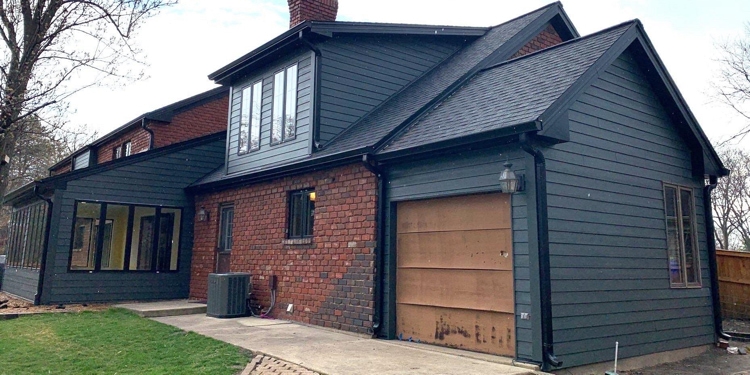
Roof replacement is the best course of action when:
- Two layers of shingles are already present
- Your roofing materials are no longer protecting your home
- Flashing or other roofing components are missing or damaged
- Moisture damage is present, pointing to existing structural problems
- Discolored interior surfaces show that moisture has penetrated through all layers of the roof and into the interior walls
It’s not uncommon for homeowners to cover all their bases by choosing a complete replacement, as this offers peace of mind that the roofing system is 100 percent intact and capable of protecting the home for many years to come. While the cost is more substantial, there is plenty of value to be realized in this investment.
Reroofing vs. roof replacement
While there are situations where a homeowner doesn’t have the option of choosing, there are times when reroofing vs. roof replacement is a hot topic because there is an actual choice to be made. Understanding the differences between the two, the pros and cons and the time and costs involved, will help guide the decision-maker to the one that is right for their home.
The table below lists characteristics of reroofing and roof replacement in an easy-to-absorb visual, detailing contrasts between the two.
Reroofing and roof replacement comparison table:
Reroofing
Roof Replacement
Appearance
Lacks clean lines
Symmetrical lines and an overall better appearance
Shingle layers
Only an option if there are less than two layers
Not an issue
Scope
Minor fix and improves aesthetics
Every component of the roof system is improved
Lifespan
Short-term solution (up to 16 years)
Long-term solution (lasting decades)
Cost
Lower cost
Higher cost
Time required
Less than three days
One week
Warranties
All material warranties are void
Comprehensive warranties
Property value
Can hurt resale value
Increases resale value
The major differences between reroofing and roof replacement
At first glance, a reroofed home will look better than it did prior to having the new shingles installed, but closer inspection will reveal what most people refer to as a “less uniform appearance.” A more specific explanation would be that a reroofed home lacks the crisp, clean lines of a replaced roof. It’s not always the case, but sometimes the old shingles are visible under the new ones.
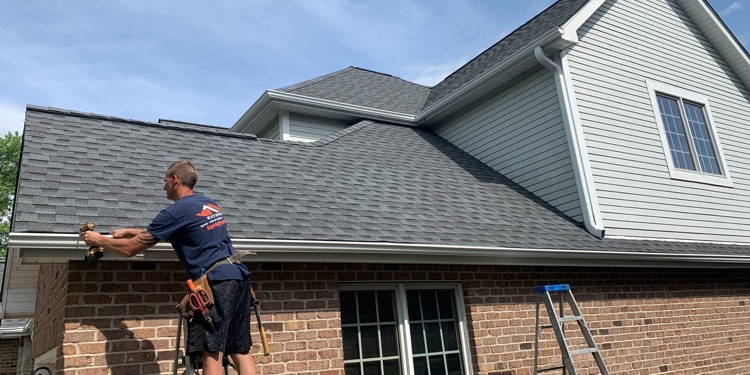
It is the existing shingles that are generally to blame for the less-than-perfect aesthetic of a reroofing job, as there is no uniformity to them, which means the roofer is already at a disadvantage trying to install new shingles.
In comparison, a roof that has been replaced has the advantage of a “clean slate,” meaning the new materials are placed atop the even decking surface, presenting the advantage of uniformity. With the old shingles removed, there is no barrier to a cleaner, more uniform look, which is quite a bit more appealing to the eye. Side by side, it will be obvious which one has more curb appeal.
Aesthetics aside, the other major difference between the two is the scope of the work. The reroofing job might delay potential leaks caused by failing old shingles, but it is a temporary fix. Roof replacement, on the other hand, has a far more expansive scope, as all the materials are replaced, so everything from the vapor barrier to the flashing to the shingles offers peak performance and will have decades of life ahead of them.
If your preference is to reroof but you’ve already got two layers on your roof, you won’t have that as an option. However, with roof replacement, it doesn’t matter how many layers are present, because everything is coming off, which in some cases could include some or all of the decking.
Is there a durability difference between the two? As you might have guessed, the roof replacement certainly offers the upper hand in the durability contest. While reroofing does offer some leak protection, it’s largely considered a cosmetic fix with no real goal of being a long-term solution. But with roof replacement, you get the cosmetic perk plus the years and years of protection that a completely new roofing system offers.
The next question most homeowners have is, “do you pay for the added durability of a roof replacement?” And the answer is “yes.” Due to the added materials and labor associated with roof replacement, the cost is significantly higher than a reroofing project.
But is the added cost worth it? That’s a good question and the answer is, “definitely.” First off, you don’t void material warranties like you do with a reroofing project, which means your materials will be covered for decades instead of voided. There is also value in the fact that your home will be safe with all new components of the roof system protecting your home.
And finally, a remarkable difference between the two is that your resale value will be much more attractive with a roof replacement than with reroofing. Not only do you get added curb appeal out of your fully replaced roof, but you provide potential buyers with the reassurance that they will not have to take on a roofing project any time in the near future, or perhaps even distant future.
Cost of reroofing vs. roof replacement
One of the more substantial arguments in the reroofing vs. roof replacement discussion is cost. Any roofing project price tag, from repairs to reroofing to replacement, will be impacted by the size of the home, the type of materials being used and the difficulty associated with doing the work (steep roof, many obstacles). However, provided that a roof replacement is much more extensive than a reroofing project, it is clear which one will hit the pocketbook harder.

While a roof on any home serves the same purpose, the level of slope and height of the roof will vary from home to home, and this will have an impact on how much your labor charges will be. For example, when roofers can access the roof of a home easily and the roof has barely any slope to it, they can quickly and easily do all kinds of work on it. Therefore, this type of home will have the minimum amount of labor charges. However, if the home has a roof that is high off the ground, is steep and has multiple rooftop components, such as chimneys, skylights, vents, etc., then the roofers will have difficulty completing their tasks, resulting in higher labor costs.
But there are also the material costs to consider. With a reroofing project, you’re limited to asphalt shingles, as those are the only material types that can be placed over existing roofing materials. The cost will be anywhere from $5,000 for basic shingles to $12,000 for premium, high-quality durable shingles.
While a roof replacement affords you the luxury of choosing any type of material, from slate to tile to wood, you will have the added expense of all the underlayment materials that protect the roof, on top of the expense of your top layer or shingles or whichever material you choose. This is why a basic replacement project will cost $14,000-plus just to get you started, but will go up depending on materials and labor.
How to decide between reroofing and fully replacing the roof
An informed decision leaves all the worry behind, as you will know you made a choice based on facts and that you’re going to have the best possible results. Most homeowners consider a variety of factors in their reroofing vs. roof replacement decision, including budgetary requirements, aesthetic preferences and much, much more.
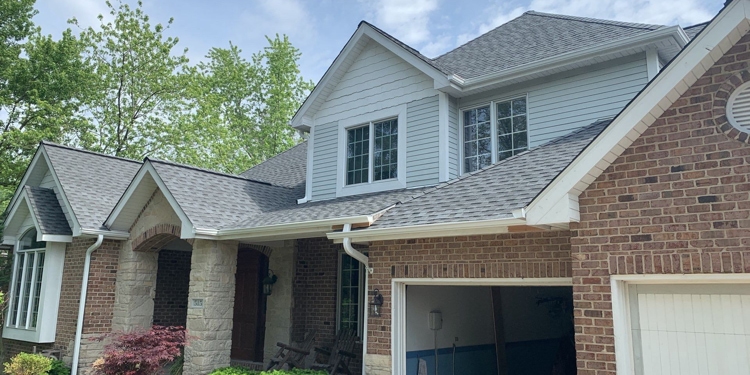
Top factors to consider:
The condition of your roof
Listed first because it is arguably the most important is the condition of your roof. When you take stock of your roofing materials, how they’re holding up, the potential life they have left in them or if they are already failing, you can make a better decision about reroofing or roof replacement. Yes, you can postpone the inevitable by making the mostly cosmetic fix, but you’ll get far more mileage out of a roof replacement.
So, ask yourself: 1) Does my roof need major work to get it to a state where it protects my home, or 2) Is the roofing system sound enough right now that a minor fix could prevent leaks for a handful of years?
Weather conditions in your area
When shingles reach the end of their lifespan, they lose their ability to hold up to adverse weather conditions. That means that a shingle that could once withstand high-velocity hits from hail will now buckle under the pressure and lead to leaks. Or, if you live in an area where heavy snow and ice are common in the winter months, your aging shingles could fail, which means you’re a better candidate for roof replacement than a reroofing, as the added weight during heavy snowfall could create too much strain on your support structures.
Conversely, if you haven’t experienced adverse weather conditions and your shingles look a bit ragged but are still functional, your roofing contractor might inform you that you’re a candidate for reroofing. In any case, digging deeper into the weather in your area and what could potentially happen in the coming years will give you more information for making the right decision.
Roof lifespan and quality
Roofing materials have a finite lifespan, and mid-budget asphalt shingles, while durable, will last between 15 and 20 years on average. You also have to consider the materials below your shingles and their lifespan and condition, as you make your decision. That means anyone considering a project on a roof that has either surpassed or is nearing the end of its lifespan is advised to choose the replacement option.
If your only goal is to get a handful of years out of your project and your contractor says your roof is a good candidate for reroofing, then that might be the best option, especially for those with a limited budget. However, this does not address the quality issue, as you’ll only realize high-quality results with a complete replacement.
The slope and complexity of your roof
While there is a value placed on intricate roofing systems in the architectural sense, these types of roofs require special tools and added labor to fix or replace. That means a reroofing project, which is almost always considered the “budget-friendly” option, becomes quite expensive because of the difficulty of installing new shingles. Rather than put an expensive bandage on a roof like this, as a reroofing project would do, the more valuable option is to make a full replacement.
The same can be said for roofs with a steep slope, which requires extra precautions to keep the roofers safe, but also slows down the rate at which they can install shingles, adding to the expense of the overall project. Again, rather than taking on an expensive cosmetic fix with reroofing, consider the long-term fix of a roof replacement because you’ll get a lot more mileage per dollar spent.
Building codes and regulations for roofing
Running afoul of your building codes could mean high fines and a lot of rework that nobody wants to go through. This is the case when a homeowner decides to have a third layer of shingles installed, which is against most city ordinances that only allow for two layers of shingles on a home. Quality roofing contractors know better than to go against the code, but homeowners are the ones who are left holding the bill in the end, so be sure you know how many layers you have on your roof before you choose the reroofing option.
While your contractor should guide you in situations like this, you should also reach out to the local agency governing building ordinances and inquire about what is legal in your area.
Budget for roofing project
Budgets almost always guide big decisions, and they should as it’s only fiscally responsible to consider what you can spend and what borrowing options and repayment plans fit into your long-term budget. The most cost-effective option is going to be the reroofing project, but it’s not always the most valuable or most effective use of your money in the long term. However, when budget constraints are the deciding factor and your contractor says reroofing is an option, it’s the best available option.
When the budget allows for a roof replacement, there are many value-added perks, such as the enhanced protection brand-new materials provide, the aesthetic improvements, the long life of the roofing system and the resale value of the home – all of which add far more value than a reroofing job can.
Make a final decision: what is the best roofing option for you?
Home improvement decisions aren’t easy, especially those regarding projects where the stakes are high. Roofing work is also expensive, which only adds to the weight of the decision. However, now that you’ve had a chance to go over the pros and cons, the reasons why you should or shouldn’t choose one or the other, you have some information in your corner that you can use to make the best decision for your home.
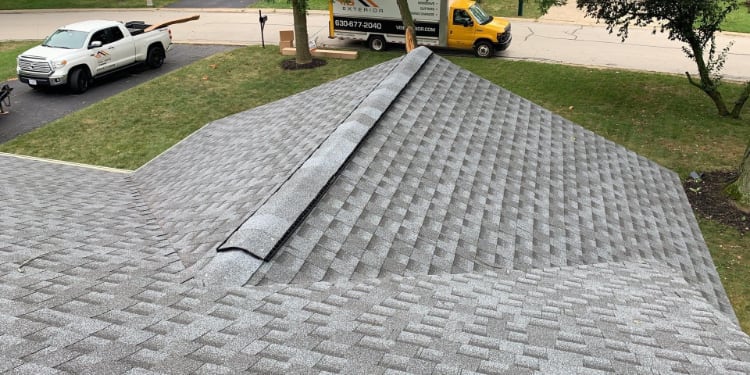
Maybe you’re a homeowner with aging shingles that no longer look fresh and new, but they haven’t posed a serious issue as a leak hazard; this is a situation where reroofing might look like the right choice for you. As long as you only have one layer of shingles on your roof right now, this option might actually work in your favor, if only for the short term.
But what if the roof already has two layers of shingles on it? Because most municipalities do not allow more than two layers, your only option is to tear off the old ones and have a new roofing system installed.
There’s also the situation where you only have one layer of shingles on your roof, but it has become obvious that the shingles and the layers under it have begun to fail – what’s the best choice here? By now you know that the cosmetic perks involved with reroofing will only be a temporary fix to your problem and that you need to choose roof replacement.
When you work with a quality roofing contractor you’ll get a thorough inspection that reveals all the trouble areas. For example, you know your roof is getting on in age so you schedule an inspection. While there might not be any signs of real damage from the ground, the inspector gets into the attic and notices water damage on the decking, perhaps even sagging in some areas. This is a sure sign that the roof has serious problems and will require more than reroofing.
It’s not fun to think about the expense of a full roof overhaul, but the upside is that the project will boost the curb appeal of your house, as well as the resale value. Furthermore, there is a lot of value to having peace of mind knowing your roof will protect your home for many, many years to come.
When reroofing is not the right option
There is the decision you hope is right for you and then there is the decision that actually is the logical choice. You hope to be spared the big expense of a full roof replacement, but the fact remains that there are reasons why reroofing is not a good choice.
Reasons why reroofing is not feasible:
- Multiple shingle layers: When you’ve already got two layers of shingles on your roof, safety building codes require you to tear them off before installing new shingles. Most roofs are not built with a support structure strong enough to hold three layers of shingles.
- Sagging roof: Even if a sagging roof is barely perceivable, it’s a red flag that something is really off and needs immediate assistance. The last thing you want is a structural problem, so tearing off the entire roof system and fixing the structure is the only option.
- Metal roofing: If you want to install asphalt shingles, they can only be installed atop other asphalt shingles, not metal. If you want to install a metal roof, you’ll be required to tear off your asphalt shingles first.
- Venting issues: Whether it’s due to improper installation or structural issues, when a roof experiences venting issues, moisture damage can occur. Roofs need to “breathe” in order to properly accommodate the rise and fall of humidity. A roof replacement addresses this issue, while a reroofing project will not.
- Architectural shingles: Architectural shingles are sought after for their thick design, which gives them extra durability and an aesthetic appeal, but it’s not recommended to install new shingles over them because of the likelihood of uneven, unattractive appearance and potentially compromised ability to protect the home.
Reroofing is almost always thought of as a temporary fix, which is why it is never recommended on a roof with serious issues that can only be addressed with a complete replacement. Make sure you ask plenty of questions of your roofing contractor and their reasoning for why a reroofing project may or may not be ideal for your home.
A whole new roof is a worthwhile investment
The word “investment” can be used rather loosely at times, but when addressing a roof replacement as an investment, it certainly fits the definition. Is a brand new roof expensive? Yes, to most homeowners it is a major expense that ranks among the highest on costs related to home improvement projects, but the upside is that there is a whole lot of value in it.
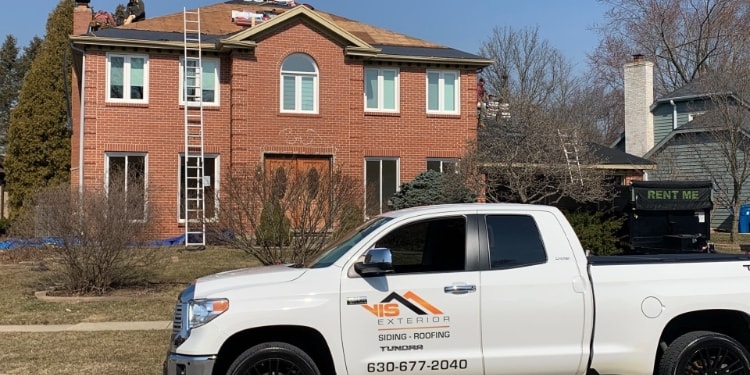
While reroofing is a temporary fix that will cost you less money, the long-term costs might be more when you consider that reroofed homes will need to be evaluated in the near future, perhaps even requiring a roof replacement. Therefore, it becomes obvious that your investment in a roof replacement has far more value than the money you spent on the temporary, largely cosmetic reroofing project.
There are certainly aesthetic advantages to getting a whole new roof, and that does add curb appeal to a home and plenty of value in terms of attracting potential buyers, there is also the resale value improvement you’ll see on a house with an entirely new roof.
So, yes – a new roof is a sound investment, but one thing that is priceless to so many homeowners is the protection it brings and the invaluable peace of mind knowing you’re securely covered for a minimum of two decades.
Choose the best roofer for full roof replacement in DuPage County
Choosing the best roofer for your project should be at the top of your list of tasks as you plan your project. But what makes a roofing contractor a “quality” partner? When you take on a full roof replacement project, you want someone with years of experience on your side – someone who has worked on your type of house and can walk you through exactly what is going to happen.
But you also need to do your research and weed out roofing contractors who can’t provide plenty of referrals and examples of their work. That’s why it’s so important to choose someone local. Not only do they have referrals, they probably have homes close to yours that they’ve worked on and you can see, first hand, what they’re capable of doing.
When DuPage County residents need someone they can trust, they call on VIS Exterior because we’re a local company that has proven time and again that we are passionate about what we do. As a contractor who has nearly two decades of experience working with homeowners on all types of homes, we know exactly what to expect when we take on a full roof replacement job.
We take pride in what we do because we live and work among the very people we serve, so contact us and let’s schedule a meeting so we can help you decide which direction your roofing project needs to take.
